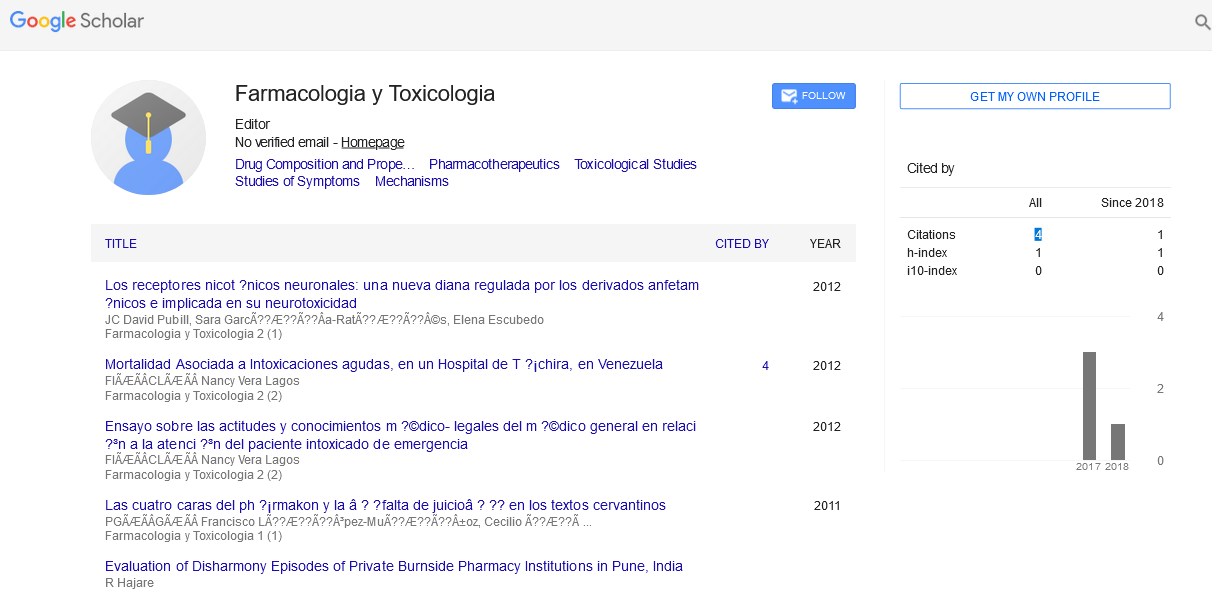Perspective - (2024) Volume 14, Issue 3
Unearthing Toxicologic Evidence: Navigating the Ethical Landscape of Mining Data for Public Health
Redouane Semaoui*
Department of Toxicology, University of HwaZulu, Durban, South Africa
*Correspondence:
Redouane Semaoui, Department of Toxicology, University of HwaZulu, Durban,
South Africa,
Email:
Received: 04-May-2024, Manuscript No. IPFT-24-14767;
Editor assigned: 08-May-2024, Pre QC No. IPFT-24-14767 (PQ);
Reviewed: 22-May-2024, QC No. IPFT-24-14767;
Revised: 04-Jun-2024, Manuscript No. IPFT-24-14767 (R);
Published:
14-Jun-2024
Introduction
In the era of big data and advanced analytics, the field of
toxicology is experiencing a revolution. Traditional methods of
toxicological analysis often rely on controlled experiments or
observational studies, which can be time-consuming, costly and
limited in scope. However, the advent of data mining techniques
has opened up new avenues for researchers to explore
toxicologic evidence on a scale previously unimaginable. But
with great power comes great responsibility. As we delve into
the realm of mining toxicologic evidence, ethical considerations
loom large. This article aims to explore the nuances of mining
toxicologic evidence while navigating the ethical landscape to
ensure the integrity of public health research.
Description
Understanding toxicologic evidence
Toxicologic evidence encompasses a wide range of data
related to the effects of toxic substances on living organisms.
This includes information on chemical properties, exposure
pathways, biological responses and health outcomes associated
with toxicants. Traditionally, toxicologists have relied on
controlled experiments, animal studies, epidemiological
investigations and clinical trials to gather such evidence. While
these methods have yielded valuable insights, they are often
constrained by practical limitations such as sample size, study
duration and ethical considerations.
Enter data mining-a computational approach that involves
extracting patterns and insights from large datasets. In the
context of toxicology, data mining techniques can be applied to
diverse sources of information, including environmental
monitoring data, health records, genetic databases and scientific
literature. By analyzing vast amounts of data, researchers can
identify associations, trends and risk factors that may not be
apparent through traditional methods alone.
The promise of data mining in toxicology
The potential benefits of data mining in toxicology are
manifold. Firstly, it allows researchers to leverage existing data
sources to generate new hypotheses and discoveries.
For example, by analyzing environmental monitoring data
alongside health outcomes, researchers can identify
correlations between pollutant levels and disease incidence.
This can inform public health interventions and regulatory
decisions aimed at reducing exposure to harmful substances.
Secondly, data mining enables researchers to uncover subtle
patterns and interactions that may not be evident through
conventional analyses. Machine learning algorithms, for
instance, can identify complex relationships between multiple
variables, leading to a deeper understanding of toxicological
mechanisms. This can facilitate the development of predictive
models to assess the health risks associated with exposure to
specific chemicals or environmental conditions.
Moreover, data mining can accelerate the pace of
toxicological research by automating repetitive tasks and
streamlining data analysis workflows. This not only enhances
efficiency but also enables researchers to focus their efforts on
areas of greatest relevance and impact. Additionally, data
mining techniques can help integrate diverse datasets from
different sources, thereby enabling a more holistic approach to
toxicological assessment.
Ethical considerations in mining toxicologic evidence
Despite its potential, mining toxicologic evidence raises
significant ethical concerns that must be addressed. One of the
primary considerations is data privacy and confidentiality. Many
toxicological datasets contain sensitive information about
individuals, such as their health status, genetic profile or
environmental exposures. Unauthorized access or misuse of
such data could compromise privacy rights and violate ethical
principles.
To mitigate these risks, researchers must adhere to strict data
protection protocols and obtain informed consent from study
participants whenever possible. This involves transparently
communicating the purposes of data mining activities, the
potential risks and benefits and the rights of individuals to optout
or withdraw their consent at any time. Additionally,
researchers should anonymize or de-identify personal
information to prevent re-identification of individuals from the
dataset.
Another ethical concern relates to data bias and
representativeness. Toxicological datasets are often derived from
specific populations or geographical regions, which may not be
representative of the broader population. Biases in the data,
such as underrepresentation of certain demographic groups or
overrepresentation of certain exposures, can lead to skewed
results and erroneous conclusions. To address this issue,
researchers must strive to use diverse and inclusive datasets
that accurately reflect the demographics and characteristics of
the target population.
Furthermore, there are ethical considerations surrounding the
interpretation and communication of findings from data mining
studies. The complexity of data mining algorithms and the
inherent uncertainty in predictive models can make it
challenging to convey results in a clear and understandable
manner. Researchers have a responsibility to ensure that their
findings are accurately interpreted and communicated to
stakeholders, including policymakers, healthcare professionals
and the general public. This may involve providing context,
acknowledging limitations and avoiding sensationalism or
exaggeration.
In addition, there are broader ethical implications
associated with the use of toxicologic evidence in decision making and policy formulation. The findings of data mining
studies may have far-reaching consequences for public health,
environmental regulation and social equity. It is essential for
researchers to consider the potential impact of their work on
vulnerable populations, marginalized communities and future
generations. This requires a commitment to equity, justice and
inclusivity in all stages of the research process, from data
collection to dissemination of results.
Conclusion
Mining toxicologic evidence holds great promise for advancing
our understanding of the health effects of toxic substances and
informing evidence-based interventions. However, this approach
is not without its ethical challenges. Researchers must navigate a
complex landscape of data privacy, bias, interpretation and
societal impact to ensure that their work upholds the highest
standards of integrity and accountability. By addressing these
ethical considerations proactively, we can harness the power of
data mining to promote public health and environmental
sustainability for generations to come.
Citation: Semaoui R (2024) Unearthing Toxicologic Evidence: Navigating the Ethical Landscape of Mining Data for Public Health. Farmacologia
Toxicologia Vol.14 No.3: 024





